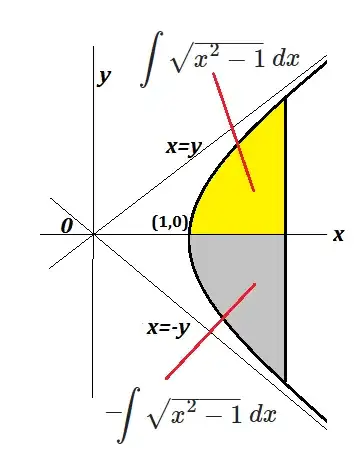I tried evaluating $\int\sqrt{x^2-1}\ dx$ using the substitution $x = \sec u$
I know my method gets to the same answer as WolframAlpha, namely:
$$\int\sqrt{x^2-1}\ dx = \frac{1}{2} \left(\ x \sqrt{x^2-1} - \ln\left|x + \sqrt{x^2-1}\right|\ \right) + C,\quad (*)$$
but there is one step I can't justify. When I got to $$\int \tan^2(u)\sec(u)\ du = \frac{1}{2}\left(\ \tan(u)\sec(u) - \ln\left|\sec(u)+\tan(u)\right|\ \right) + C,$$ I then have to substitute stuff back in terms of $x$. Now $$x=\sec(u) \implies \tan^2(u) = x^2 - 1,$$ but I don't see how this implies $\tan(u) = \sqrt{x^2 - 1}$.
Comparing the graphs of $\sec(u)$ and $\tan(u)$, I don't see why not: $\ \tan(u) = -\sqrt{x^2 - 1}$, which would give:
$$\int\sqrt{x^2-1}\ dx = \frac{1}{2} \left(\ -x \sqrt{x^2-1} - \ln\left|x - \sqrt{x^2-1}\right|\ \right) + C,\quad (**)$$
which is a different answer than $(*)$ ?
Now I noticed that $(*) = -(**)\ $ (ignoring the $C \to -C)$.
I can see from the graph of $\sqrt{x^2-1}$ that for $x>1$, the definite integral $\int^x_1\sqrt{t^2-1}\ dt = (*),$ and for $x<-1,\ \int^{-1}_x\sqrt{t^2-1}\ dt = (**)$
So is the indefinite integral sort of poorly defined, or would you say it is:
$$\int\sqrt{x^2-1}\ dx = \pm \frac{1}{2} \left(\ x \sqrt{x^2-1} - \ln\left|x + \sqrt{x^2-1}\right|\ \right) + C?$$
